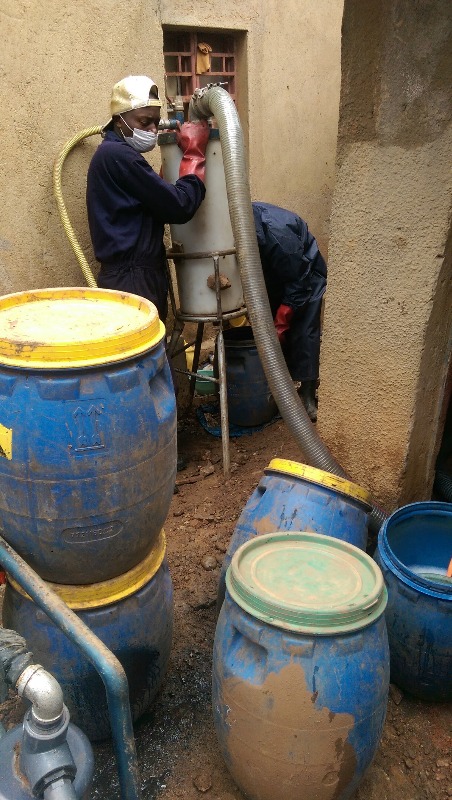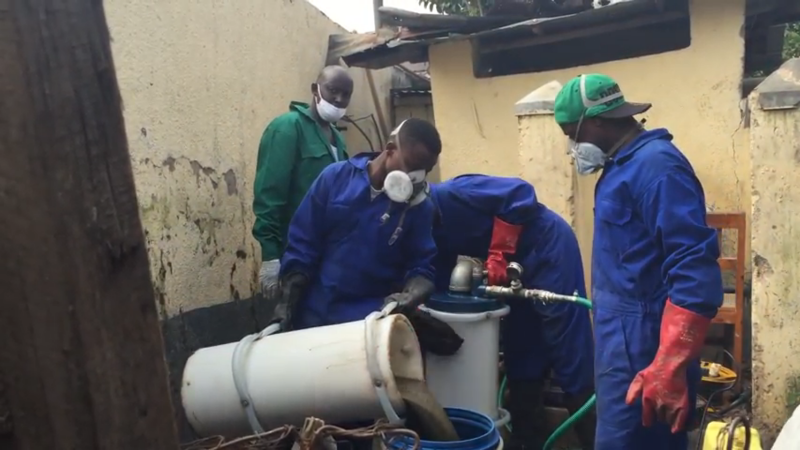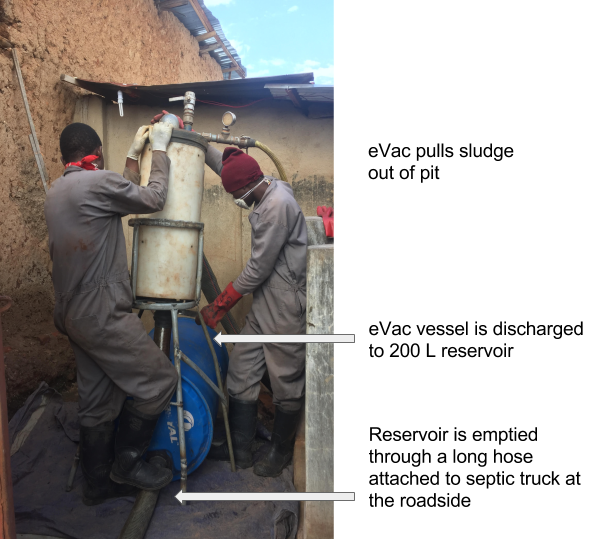- Forum
- categories
- Sanitation systems
- Faecal sludge management (FSM)
- Faecal sludge transport (including emptying of pits and septic tanks, transfer stations)
- DoVac - a new method for fecal sludge transport from pit to road?
DoVac - a new method for fecal sludge transport from pit to road?
11.9k views
Re: DoVac - a new method for fecal sludge transport from pit to road?
Dear Ms. Laura,
Thanks for your inputs on cost component. The costs would vary from one region to another. Sometimes, the government offers tax relaxation on solid waste vehicles to reduce their costs. As you say, motor tricycles can be used for smaller amounts of sludge.
Although, this post limits itself to "sludge transport from pit to road," you say: "but here the path to the treatment site is too far, rough, and steep to allow for smaller vehicles," could you kindly comment on the "treatment" aspect, like what sort of treatment is given to the sludge - aerobic or anaerobic; how do you determine whether the sludge is fully stabilized (are their any guidelines from international agencies); and what you do with the final product.
Regards,
F H Mughal
Thanks for your inputs on cost component. The costs would vary from one region to another. Sometimes, the government offers tax relaxation on solid waste vehicles to reduce their costs. As you say, motor tricycles can be used for smaller amounts of sludge.
Although, this post limits itself to "sludge transport from pit to road," you say: "but here the path to the treatment site is too far, rough, and steep to allow for smaller vehicles," could you kindly comment on the "treatment" aspect, like what sort of treatment is given to the sludge - aerobic or anaerobic; how do you determine whether the sludge is fully stabilized (are their any guidelines from international agencies); and what you do with the final product.
Regards,
F H Mughal
F H Mughal (Mr.)
Karachi, Pakistan
Karachi, Pakistan
Please Log in to join the conversation.
You need to login to replyRe: DoVac - a new method for fecal sludge transport from pit to road?
mst wrote: @Kris, Thanks for the lead! Do you know anyone using this technology in the field or pairing it with a vacuum truck?
Sorry, no. That was just a link I had in my bookmarks as a possible supplier for a small mobile vacuum pump system.
However regarding the costs: that seems to be still an order of magnitude too expensive to be commercially viable (assuming a target of less affluent households).
Do you really need the expensive vacuum truck? I understand that you had bad experiences with manually hauling and transporting the barrels, but what about the following:
Assuming the pit contents are quite liquid and that you can do some simple sieving or quick removal of sharp object in the first barrel, why not utilize a large diameter diaphragm pump for the second step? That way you can have more flexibility as it works both as a suction and a pressure pump and you can use a single tractor with several cheap trailer mounted tanks to transport it. In addition you can use the much cheaper and easier to handle 4" or 6" flat hoses for the delivery to those trailer tanks (that is also much more durable, as those green rigid suction hoses start leaking quite quickly with normal handling).
See here for an commercial example of those diaphragm pumps: www.wastecorp.com/diaphragm-pumps.html
I also posted some pictures of a cheap locally build version here: forum.susana.org/forum/categories/99-fae...the-answer-is-#17220
Please Log in to join the conversation.
You need to login to reply- mst
-
 Topic Author
Topic Author- Laura Stupin | Freelance Field Engineer | Kigali, Rwanda
Less- Posts: 3
- Likes received: 2
Re: DoVac - a new method for fecal sludge transport from pit to road?
@Kris, Thanks for the lead! Do you know anyone using this technology in the field or pairing it with a vacuum truck?
@F H Mugal
Capital Cost
The truck is clearly the largest part of the capital cost. Since we need a large truck anyway to transport barrels, the difference between a vacuum truck and a normal truck of similar weight capacities seems to be around $5000-7000 more for the vacuum truck. In Kigali, we cannot avoid having a large vehicle. In other places, smaller vehicles like motor tricycles can be used to transport smaller amounts of sludge, but here the path to the treatment site is too far, rough, and steep to allow for smaller vehicles.
Operating Cost
The cost of one empty is around $80-100 right now, the majority of that is for transport. At the moment we are renting vehicles, and we will be purchasing our own vehicle soon, it should drop the cost by 20-30%. $80-100 is on the same range of cost for calling a normal vacuum truck in Kigali. However, we think the key to servicing lower income households is to cluster empties together - serve multiple households that are close neighbors at the same time. This would significantly reduce the transport cost and logistics. We’ve considered sludge transfer stations to create “artificial clustering”, but right now we feel the most straightforward method is to treat the vacuum truck as a mobile transfer station and fill it with as many empties as possible before taking the sludge to the treatment site. We’re exploring different methods for clustering households through a referral program and also considering having households sign up and wait to be clustered when other households in their area are ready.
Reducing operating cost per empty is the top priority of our research and development now. We would love to hear more from other groups working on similar projects.
Maintenance Cost
For the eVac, we spent an average of $50/month maintaining 3 eVacs, although not all of them are in constant use right now. We don’t have first hand experience with the maintenance cost of vacuum trucks yet, this report has information about vacuum truck maintenance costs in different countries.
@F H Mugal
Capital Cost
| Item | Approximate Cost |
| Hopper eVac, manufactured in Kigali | $2000 |
| 120 m of suction hose | $1000 |
| Vacuum truck, 6-10 m3 capacity, imported into Kigali, including taxes | $59,000-$73,000 |
The truck is clearly the largest part of the capital cost. Since we need a large truck anyway to transport barrels, the difference between a vacuum truck and a normal truck of similar weight capacities seems to be around $5000-7000 more for the vacuum truck. In Kigali, we cannot avoid having a large vehicle. In other places, smaller vehicles like motor tricycles can be used to transport smaller amounts of sludge, but here the path to the treatment site is too far, rough, and steep to allow for smaller vehicles.
Operating Cost
The cost of one empty is around $80-100 right now, the majority of that is for transport. At the moment we are renting vehicles, and we will be purchasing our own vehicle soon, it should drop the cost by 20-30%. $80-100 is on the same range of cost for calling a normal vacuum truck in Kigali. However, we think the key to servicing lower income households is to cluster empties together - serve multiple households that are close neighbors at the same time. This would significantly reduce the transport cost and logistics. We’ve considered sludge transfer stations to create “artificial clustering”, but right now we feel the most straightforward method is to treat the vacuum truck as a mobile transfer station and fill it with as many empties as possible before taking the sludge to the treatment site. We’re exploring different methods for clustering households through a referral program and also considering having households sign up and wait to be clustered when other households in their area are ready.
Reducing operating cost per empty is the top priority of our research and development now. We would love to hear more from other groups working on similar projects.
Maintenance Cost
For the eVac, we spent an average of $50/month maintaining 3 eVacs, although not all of them are in constant use right now. We don’t have first hand experience with the maintenance cost of vacuum trucks yet, this report has information about vacuum truck maintenance costs in different countries.
Laura Stupin
Freelance Field Engineer
Kigali, Rwanda
Freelance Field Engineer
Kigali, Rwanda
The following user(s) like this post: Elisabeth
Please Log in to join the conversation.
You need to login to replyRe: DoVac - a new method for fecal sludge transport from pit to road?
Dear Ms. Laura,
Could you kindly reflect on the cost component of the project (the capital cost and, operation and maintenance cost).
Regards,
F H Mughal
Could you kindly reflect on the cost component of the project (the capital cost and, operation and maintenance cost).
Regards,
F H Mughal
F H Mughal (Mr.)
Karachi, Pakistan
Karachi, Pakistan
Please Log in to join the conversation.
You need to login to replyRe: DoVac - a new method for fecal sludge transport from pit to road?
Seems very similar to what this company is doing:
www.elastec.com/products/vacuum-systems/minivac/
www.elastec.com/products/vacuum-systems/minivac/
Please Log in to join the conversation.
You need to login to reply- mst
-
 Topic Author
Topic Author- Laura Stupin | Freelance Field Engineer | Kigali, Rwanda
Less- Posts: 3
- Likes received: 2
Background
Kigali, Rwanda has 1.2 million people, 1 million use pit latrines. Currently, the vast majority of these pit latrines cannot be serviced with a vacuum truck.
Solution
DoVac (Double Vacuum) System
Details
For the past year, Pivot’s Pit Vidura team has been emptying pit latrines in Kigali using eVacs based on the design from Partners in Development . Here’s the original eVac in action in Kigali:
The Pit Vidura team modified the eVac to include a valve at the bottom of the white vacuum vessel. Instead of manual picking up the vessel and pouring, the valve quickly dumps the sludge into the barrel below it. We call it the “hopper eVac.”
However, each empty requires an average of 70 barrels to be carried from the pit to a truck at the roadside, up to 160 meters away. Furthermore, when the barrels of sludge are unloaded at the Pivot Works waste-to-fuel factory, it takes an additional 2-3 hours to empty each barrel and then wash and sanitize the outside so they can be used again.
Thus, Pit Vidura wanted to develop a pit-to-road system to reduce the time (and cost) wasted with barrel handling so that more pits could be serviced within one day. We tried a few different trash and sludge pumps to pump from the eVac to the road and quickly realized that they all fouled quickly because small pieces of trash like condoms and hair become entangled on the impeller, blocking the pump.
The most trash tolerant pump we knew was the eVac, which passes smaller pieces of trash easily because the sludge never flows through the pump impeller itself, so the impeller is safe from fouling. What if we could pump to the road with a similar method?
Vacuum trucks are a larger version of an eVac - an air pump creates vacuum pressure that pulls sludge into a large tank. Typically the biggest bottleneck for any suction pump is the height it needs to pull up. Vacuum trucks in Kigali can usually pull sludge from a depth of 6-7 meters below the surface. However, a truck does not have the power to pull up 7 meters, then across an additional 100 meters to the roadside. We decided to split the problem in two - the eVac pulls the sludge up 6-7 meters to the top of the pit and the truck pulls it 100+ meters to the roadside. On 9 June 2017, we ran a successful field trial emptying a full pit and pulling sludge 110 meters to the nearest road. Based on the trial performance, we expect that longer distances are possible and will be conducting further trials as we continue to empty pit latrines.
This solution only works when the truck can park level with or downhill from the top of the pit. Kigali is a very hilly city, but based on the hundreds of pits we’ve emptied so far, 65% of empties are flat or downhill and can be serviced by the DoVac system. We are in process of developing another solution for uphill empties.
Questions:
Kigali, Rwanda has 1.2 million people, 1 million use pit latrines. Currently, the vast majority of these pit latrines cannot be serviced with a vacuum truck.
- Trash content is high in pit latrines, it clogs the hoses of vacuum trucks.
- 60% of pit latrines are located farther than 40 meters from the nearest road.
Solution
DoVac (Double Vacuum) System
- Fish out large trash (bottles, clothing) manually from the pit with trash fishing tools
- Pump sludge and smaller trash to the top of the pit with a hopper eVac
- Release sludge into 200 L reservoir
- Pump from 200 L reservoir to the road with a vacuum truck
Details
For the past year, Pivot’s Pit Vidura team has been emptying pit latrines in Kigali using eVacs based on the design from Partners in Development . Here’s the original eVac in action in Kigali:
The Pit Vidura team modified the eVac to include a valve at the bottom of the white vacuum vessel. Instead of manual picking up the vessel and pouring, the valve quickly dumps the sludge into the barrel below it. We call it the “hopper eVac.”
However, each empty requires an average of 70 barrels to be carried from the pit to a truck at the roadside, up to 160 meters away. Furthermore, when the barrels of sludge are unloaded at the Pivot Works waste-to-fuel factory, it takes an additional 2-3 hours to empty each barrel and then wash and sanitize the outside so they can be used again.
Thus, Pit Vidura wanted to develop a pit-to-road system to reduce the time (and cost) wasted with barrel handling so that more pits could be serviced within one day. We tried a few different trash and sludge pumps to pump from the eVac to the road and quickly realized that they all fouled quickly because small pieces of trash like condoms and hair become entangled on the impeller, blocking the pump.
The most trash tolerant pump we knew was the eVac, which passes smaller pieces of trash easily because the sludge never flows through the pump impeller itself, so the impeller is safe from fouling. What if we could pump to the road with a similar method?
Vacuum trucks are a larger version of an eVac - an air pump creates vacuum pressure that pulls sludge into a large tank. Typically the biggest bottleneck for any suction pump is the height it needs to pull up. Vacuum trucks in Kigali can usually pull sludge from a depth of 6-7 meters below the surface. However, a truck does not have the power to pull up 7 meters, then across an additional 100 meters to the roadside. We decided to split the problem in two - the eVac pulls the sludge up 6-7 meters to the top of the pit and the truck pulls it 100+ meters to the roadside. On 9 June 2017, we ran a successful field trial emptying a full pit and pulling sludge 110 meters to the nearest road. Based on the trial performance, we expect that longer distances are possible and will be conducting further trials as we continue to empty pit latrines.
This solution only works when the truck can park level with or downhill from the top of the pit. Kigali is a very hilly city, but based on the hundreds of pits we’ve emptied so far, 65% of empties are flat or downhill and can be serviced by the DoVac system. We are in process of developing another solution for uphill empties.
Questions:
- We think this may be the first time that anyone has paired these technologies to solve the problem of the long distance to the roadside. Do you know any other groups that are using similar systems we should reach out to swap ideas? Or any groups that have used systems like this in the past?
- Do you know any other city contexts where this system might work well? Kigali has soil that is clay and rock, so pit latrines here tend to retain a lot of liquid. Also, pit latrine volumes tend to be quite large as pits can be more than 10 meters deep.
Laura Stupin
Freelance Field Engineer
Kigali, Rwanda
Freelance Field Engineer
Kigali, Rwanda
Attachments:
-
 truck.jpg
(Filesize: 130KB)
truck.jpg
(Filesize: 130KB)
-
 hopper-evac.jpg
(Filesize: 154KB)
hopper-evac.jpg
(Filesize: 154KB)
-
 Orig-evac.png
(Filesize: 569KB)
Orig-evac.png
(Filesize: 569KB)
-
 DoVacexplanation.png
(Filesize: 449KB)
DoVacexplanation.png
(Filesize: 449KB)
The following user(s) like this post: goeco
Please Log in to join the conversation.
You need to login to reply
Share this thread:
- Forum
- categories
- Sanitation systems
- Faecal sludge management (FSM)
- Faecal sludge transport (including emptying of pits and septic tanks, transfer stations)
- DoVac - a new method for fecal sludge transport from pit to road?
Recently active users. Who else has been active?
Time to create page: 1.241 seconds








